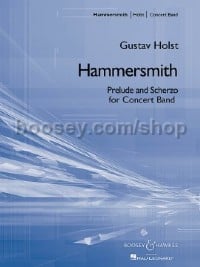Hammersmith: Prelude & Scherzo (Symphonic Band Score & Parts)
Hammersmith: Prelude & Scherzo (Symphonic Band Score & Parts)
* Estimated price converted from UK retail price
Nineteen long years passed between the composition of Holst's last two works for winds, the Second Suite in F and the masterful Hammersmith. Commissioned by the British Broadcasting Corporation (BBC) for its military band, Hammersmith was Holst's first band work for professional musicians, the earlier suites having been composed for amateur bands. Holst was to have conducted the first perfomance at the third annual convention of the American Bandmasters Association, but he was forced to cancel his appearance due to illness. The premiere took place as scheduled on April 17, 1932 at Constitution Hall in Washington, D.C. by the United States Marine Band led by their director, Taylor Branson. Hammersmith (in its original incarnation, Holst later re-wrote it for symphony orchestra) remained unpublished and did not receive another performance until nearly 22 years later. When that long-delayed second performance finally arrived, it was given by an American band (the Kiltie Band of the Carnegie Institute of Technology -now Carnegie Melon University- in Pittsburgh, PA on 14 April 1954, Robert Cantrick, conductor).
The score bears the dedication "To the Author of the Water Gypsies." This author is Alan P. Herbert, and his 1930 novel deals with a working-class girl from Hammersmith who shares her life with two very different types of men: An illiterate barge worker and an an artist, a duality that obviously appealed to Holst.
Hammersmith is a Prelude and Scherzo, its composition a result of Holst's long familiarity with the Hammersmith metropolitan borough of London, which sits on the Thames River. At the time, 125,000 inhabitants were packed into an area of 3.6 square miles. Holst's fascination with the duality of his surroundings is reflected in his composition. The Prelude (representing the inexorable, "unnoticed and unconcerned" river) is slow and unconcerned, reflecting a duality in its very key: E Major set against F minor. The Scherzo (representing the Cockney street markets and the laughing, bustling crowds) is boisterous, exuberant, and vulgar. The music and mood of the Prelude returns at the end of the composition, bringing us back to the great slow-moving river, passing relentlessly out to sea.
- Nikk Pilato



